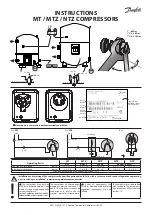
13–10–613 SP Page 10
FIGURE 2–4 – PIPING DIAGRAM FOR AFTERCOOLER AND HEAT EXCHANGER
The machine cannot be run blown
down with remote overhead oil cool-
er. These units require special wiring
diagram – check with factory. Run-
ning the machine blown down with an
overhead cooler could result in dam-
age to compressor.
All piping and wiring between the compressor unit and
the remote oil cooler is to be supplied by the user. THE
DESIGN OF THE REMOTE OIL COOLER MODULE
SYSTEM MUST BE APPROVED BY THE FACTORY
BEFORE INSTALLATION. The design information to
be submitted for approval includes:
1.
Location of oil cooler module – inside or outdoors.
2.
Range of operating ambient temperatures at the
oil cooler location.
3.
Elevation of the oil cooler above the compressor
unit.
4.
Pipe type and size(s) to be used to connect the oil
cooler and the compressor unit. Minimum pipe
size is 2–1/2” NPT.
5.
Horizontal and vertical lengths of the pipe run. If
more than one pipe size is used, list length of each
size and total length.
6.
Number and size of elbows, tees, unions, reduc-
ers, and valves to be used in the pipe run.
7.
A dimensional sketch of the proposed piping sys-
tem showing location of the compressor unit, oil
cooler, pipe, and fittings illustrating design in-
formation included in numbers 3 through 6 above.
All remote piping should be of adequate size to insure
a minimum pressure loss. Number 4 above lists the
minimum pipe size to be used. Long runs of pipe and
the use of valves and fittings require larger than the
minimum pipe sizes in the system to keep the pressure
loss low. All pipe and fittings used in a remote oil cooler
system should be galvanized or treated internally to
prevent rust, and all valves are to be of a nonferrous
construction to prevent corrosion and fouling.
The remote cooler should be placed so that the fan air
flow through the cooler (air flow is from the motor side
through core) and the prevailing winds are in the same
direction. A baffle should be provided on the exhaust
side of the cooler for protection against occasional wind
shifts.
When the oil cooler is mounted above the compressor
unit, a check valve is to be mounted on the compressor
unit in the line to the oil cooler; see FIGURE 5–4, page
45. A pneumatic pilot–operated normally–closed valve
is to be mounted at the oil filter inlet on the compressor
unit line from the oil cooler. The check valve permits oil
flow to the oil cooler during operation, but prevents re-
turn oil flow from the cooler when the unit is shut down.
The pilot valve is held open by air pressure from the unit
oil reservoir during operation and closes under spring
load when the unit is shut down to prevent return oil flow
from the oil cooler.
Summary of Contents for ELECTRA-SAVER EAYQ E
Page 15: ...13 10 613 SP Page 6 DECALS 206EAQ077 212EAQ077 218EAQ077 211EAQ077 207EAQ077 ...
Page 16: ...13 10 613 SP Page 7 DECALS 216EAQ077 217EAQ077 222EAQ077 221EAQ077 208EAQ077 ...
Page 31: ...13 10 613 SP Page 22 FIGURE 4 2 FLOW CHART FOR SET UP PROGRAMMING ...
Page 48: ...13 10 613 SP Page 39 FIGURE 4 13 WIRING DIAGRAM 202EAY546 Ref Drawing ...
Page 75: ......
















































